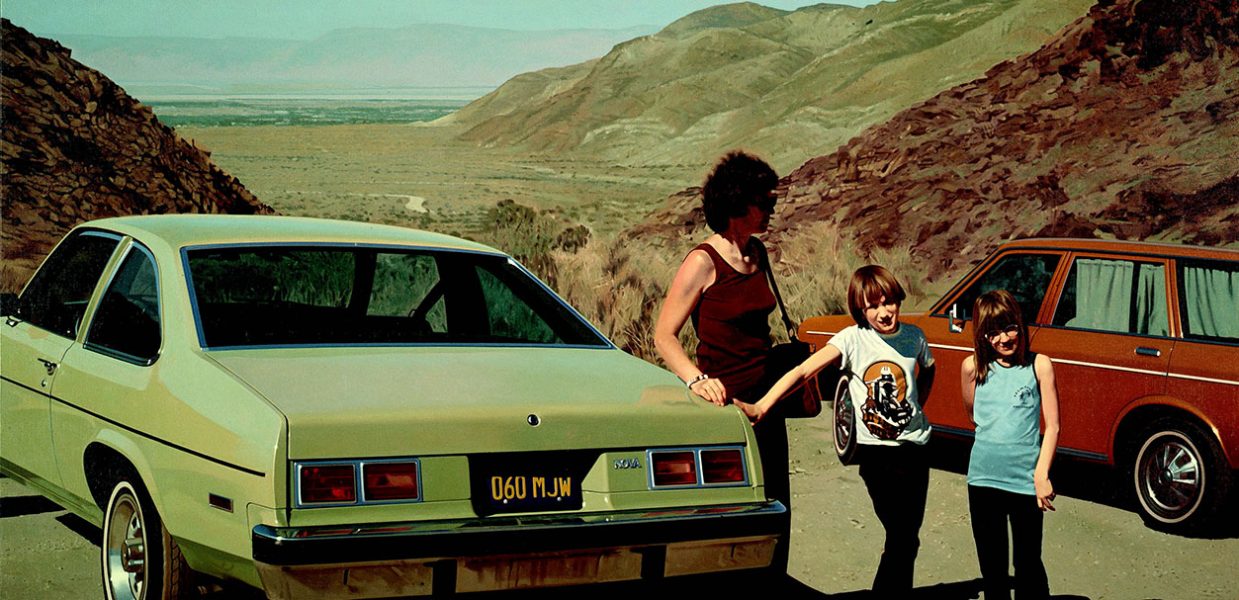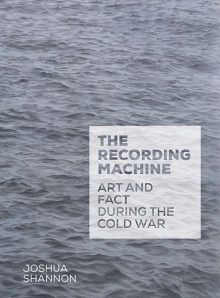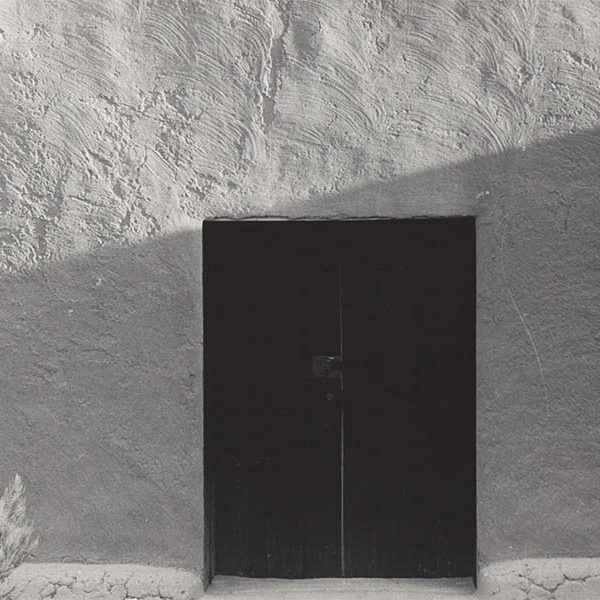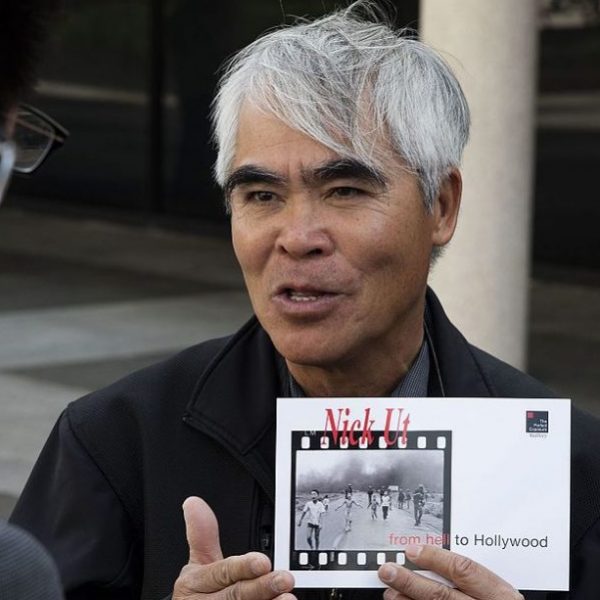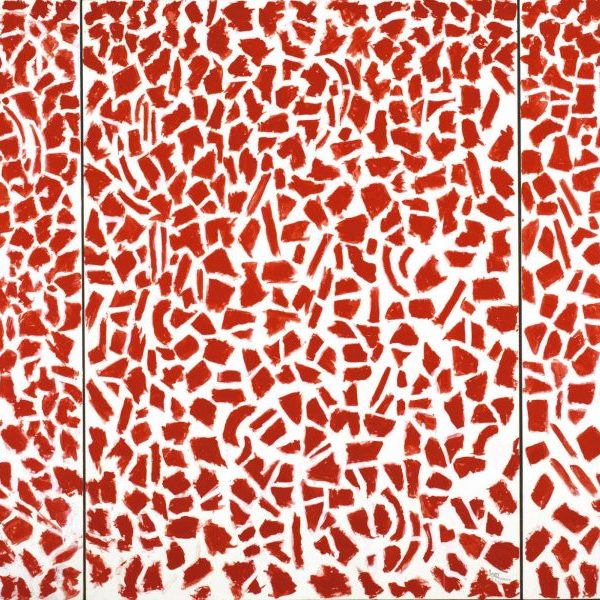The Modern Experience of Surfaces (sneak peek)
This summer, Yale University Press is delighted to publish a smart book about the transformation of photography and the visual arts around the year 1968. The book is The Recording Machine: Art and Fact During the Cold War; in it, author Joshua Shannon explains what he calls “factualism,” the tendency of certain artists to reject essential truths in favor of surface appearances. He explores this idea in a range of art, from conceptual photography and earthworks to photorealist painting and abstraction; artists featured include Bernd and Hilla Becher, Robert Bechtle, Vija Celmins, Douglas Huebler, Gerhard Richter, and others. In the excerpt below, Shannon looks at what is — and isn’t — going on in a 1975 painting by Robert Bechtle.
Around 1970, the American photorealist painter Robert Bechtle viewed the photograph as a way to act against meaning, to democratize the world against significance. If Jackson Pollock had made painting that could stand, for a moment, before or outside meaning, it was only through a radical abstraction. Bechtle’s work can be understood as an effort to achieve this meaninglessness within realism itself.
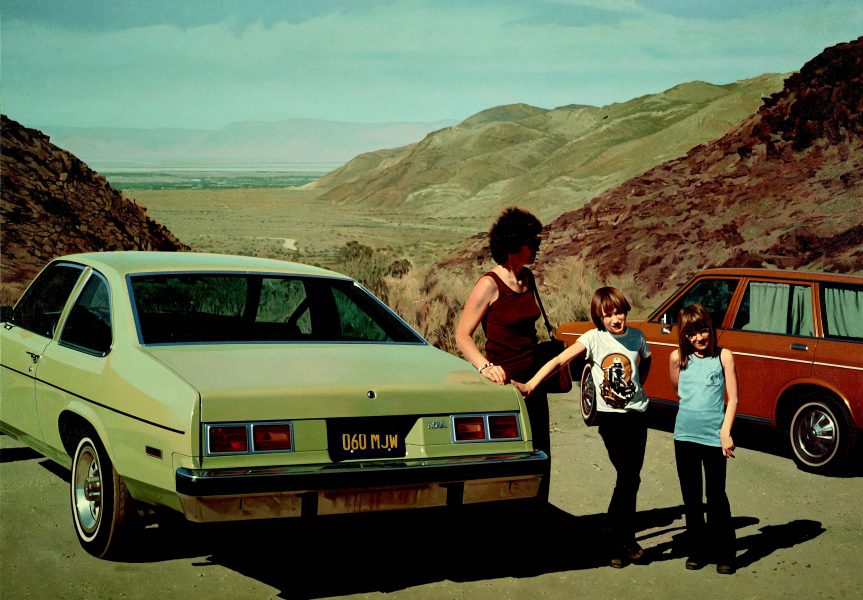
Robert Bechtle, Agua Caliente Nova, 1975. Oil on canvas, 48 × 69½ in. (121.9 × 176.5 cm). High Museum of Art, Atlanta, Purchase with funds from the National Endowment for the Arts and the Ray M. and Mary Elizabeth Lee Foundation, 1978.1.
Agua Caliente Nova of 1975 is a painting based on a photograph Bechtle took of his own family. Nancy Bechtle and the children, Max and Anne, are shown with a family car. They are posing for their father, but poorly. Nancy is looking away from the camera, her eyes are behind sunglasses, and her face is anyway fully in shadow. The children do look toward their father—that is to say, knowingly toward the artist, toward the apparatus, and toward the viewers of both the snapshot and the future painting. Squinting against the sun, however, their eyes are, like their mother’s, in shadow. In fact, with the exception of two tiny spots of white in Anne’s right eye (anyway outshone by the reflections off her glasses), their eyes are altogether invisible. Their postures suggest that they feel fatigued or put-upon by the journey, and by their father’s request for a pose. Taken a moment too early or too late, this is not an image for the family photo album: it simply does not communicate enough, or, rather, the wealth of what it communicates is both too mundane and too diffuse.
If Bechtle’s prominent inclusion of the parking lot strikes a blow against Ansel Adams’s version, for example, of pristine desert wilderness, the painting is not merely deflationary or ironic. On the contrary, it communicates enthusiasm for the beauty of this minor landmark in the Agua Caliente Indian Reservation, near Palm Springs. The yellow mid-ground grasses, the reddish-brown scree just behind it, the light green of the more distant hills in comparison to the lush valley below—these have been painted with care. Bechtle was not the first, however, to make a large oil painting inspired by family photography. Edgar Degas’s Place de la Concorde of about 1875 is a remarkably similar painting. A parent (the artist Ludovic Lepic) stares distractedly off the right edge of the canvas while a pair of children, loosely united by posture and mood, seem both to comply with and to resist a parental program. Degas’s painting, like Bechtle’s, makes a rather classically balanced composition out of the momentary and disorganized disposition of bodies in space. Both painters, too, have deployed large fields of yellow-brown: parking lot or new urban square, the situation leaves the figures adrift in empty space. Degas’s space is flatter—perhaps emptier and certainly looser than Bechtle’s desert—but, remarkably, the paintings are united by their sense of photographic contingency. The Lepic family, like Bechtle’s, is caught at a moment of failing to coherently represent itself. If smartly matching, the Lepics look remarkably unfocused.
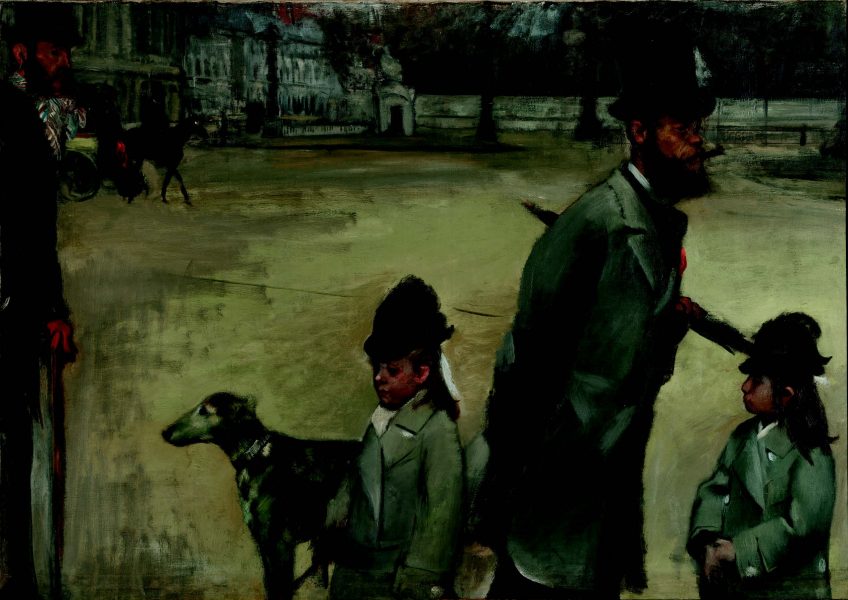
Edgar Degas, Place de la Concorde (Viscount Lepic and His Daughters Crossing the Place de la Concorde), c. 1875. Oil on canvas, 30¾ × 46¼ in. (78.4 × 117.5 cm). State Hermitage Museum, St. Petersburg. Inv. No. GE-10622.
What we do not yet see in the Degas painting, however, is the hardness and specificity of the photographic moment. If the father’s hat awkwardly overlaps for a moment with one of the sculptural urns at the periphery of the Place, his expression and those of the other figures remain general in a painterly way. Bechtle’s figures, by contrast, have all the stiff, instantaneous rigidity of having slightly failed to pose for the camera, of having been captured, that is, in one-sixtieth of a second. In Agua Caliente Nova, as in Bechtle’s painting generally, the sun seems to have worked as a fixing agent, almost like a deadly atomic flash. The painting recalls a remark by Edward Abbey about the desert, a remark quoted in fact by Nancy Holt apropos her Sun Tunnels: “Only the sunlight holds things together. Noon is the crucial hour; the desert reveals itself nakedly and cruelly, with no meaning but its own existence.” Strong light gives a superficial effect of coherence to a world of disparate and meaningless surfaces.
And this brings us to the major point: if Degas’s painting can be said to be about flatness (the confusing absence of pictorial depth, the paint as rough matter on canvas), Bechtle’s is instead about surfaces. After all, Bechtle’s picture is not especially flat—in fact the receding hills and the bodies of the two cars give it a fairly deep shape. Rather it is a painting about skin, clothing, and reflections, about chrome and bulldozed earth. Quite unlike Degas, it is furthermore built emphatically around the voids beneath those many surfaces: it is about the empty volume behind the steel and glass skin of its automobiles, about the dry California air. When I say that Bechtle’s paintings are about surface, then, I do not mean to associate them especially with the surface of modernist formalism—the surface of the canvas itself. I mean instead that they are about a new experience of surfaces as an important dissection of the history of later modernity.
Joshua Shannon is associate professor of contemporary art history and theory at the University of Maryland.























